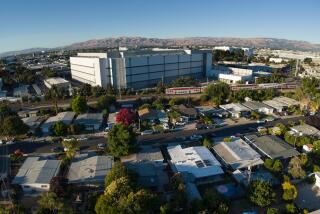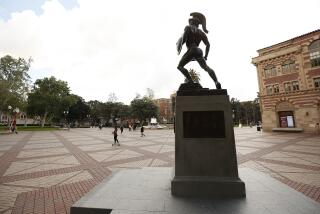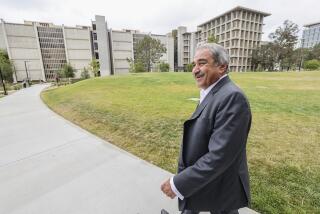Supercomputer--Big Computations From Small Package
- Share via
SAN DIEGO — The adage that big things come in small packages is true of the new supercomputer at the University of California at San Diego.
No bigger than a breadbasket, the supercomputer can perform up to 1 billion calculations a second.
“Super does not refer to size. It refers to speed,” said Freeman J. Gilbert director of UC San Diego’s Institute of Geophysics and Planetary Physics at the Scripps Institute of Oceanography.
The best computers commonly used today in scientific laboratories are from 400 to 4,000 times slower than the Cray X-MP/48, which was unveiled recently at UC San Diego.
At its center, the machine is roughly equal to the size of a breadbasket. It is surrounded by a cylindrical refrigerator to cool its components.
The National Science Foundation will spend an estimated $200 million to finance the first four supercomputer centers at UC San Diego, the University of Illinois at Urbana-Champaign, Cornell University in Ithaca, N.Y., and Princeton University in Princeton, N.J.
About 15 supercomputers are operating in the United States in private and academic research centers.
Users of the San Diego supercomputer have some big tasks in mind.
For starters, Henry D. I. Abarbanel, coordinator of the project on non-linear science at UC San Diego, hopes that the machine will reveal some of the mathematical mysteries behind the cresting of a wave or why the beating of a heart may sometimes grow irregular.
Long-range weather forecasters at the Scripps Institution of Oceanography in La Jolla think the supercomputer will improve their prognostications. Brain researchers at the Salk Institute in La Jolla are looking forward to a graphic display of the interplay of chemicals at the tip of a nerve, which may help them better understand human behavior.
And much more.
The supercomputer will be shared by academia and industry. Up to 200 scientists at a time can conduct research. Any worthwhile project would be considered, Gilbert said.
“It’s not a closed shop by any stretch of the imagination,” he said. “It’s important to emphasize that anybody may be considered--you could be just John Doe, private citizen.”
Between 100 and 200 research applications already have been submitted with several hundred more expected. Two committees are screening the applications, one at the National Science Foundation, which will allocate 60% of the computer’s time, and another by a consortium responsible for the rest.
Ten percent of the computer’s time has been set aside for use by private companies, which will pay an average of $1,300 an hour.
The La Jolla high-technology company, GA Technologies, with the support of 18 academic and research institutions, was responsible for bringing the center to San Diego. Sidney Karin of GA Technologies will operate the center with a $100-million budget for the first five years.
More than half the money will come from the science foundation and the rest will come from the state of California, users, vendors and other participants.






